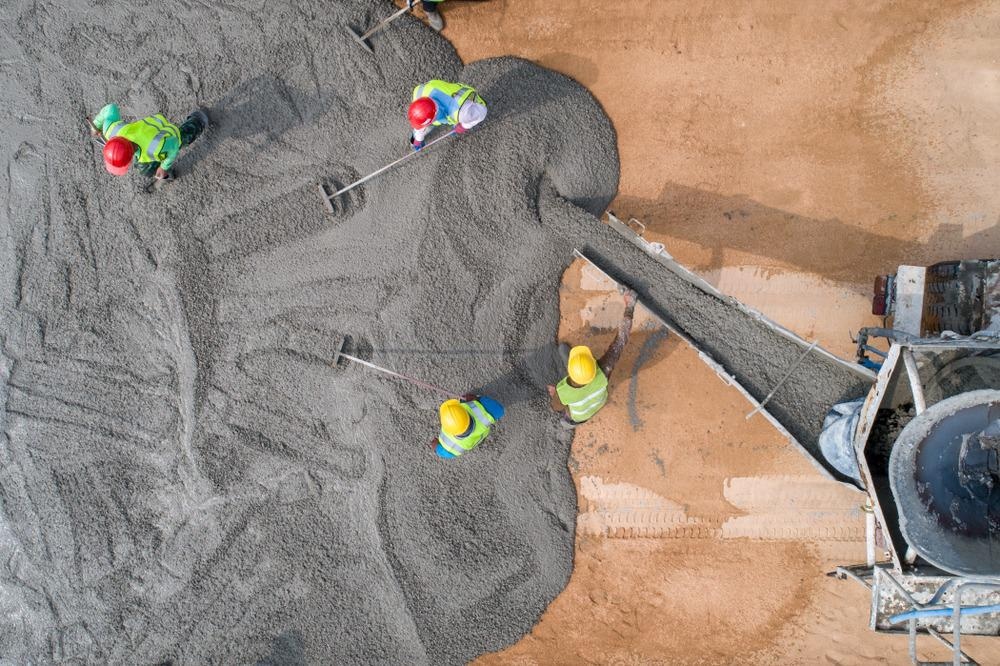To determine the water-cement ratio in concrete, various methods are used including microhardness, optical microscopy using blue dye, water-drop absorption rate, cement paste resistance to scratching, fluorescence microscopy, and SAM. This article will look at using electron microscopy to analyze concrete and, in particular, the water-cement ratio.

Image Credit: Bannafarsai_Stock/Shutterstock.com
The water-cement ratio is of critical significance for concrete. This ratio determines the ultimate strength and plays a vital role in its durability. Excessive water in the original mixture causes increased capillary permeability, decreasing durability and strength.
Scanning Electron Microscopy for Water-Cement Ratio
SEM or scanning electron microscopy is a very effective method for analyzing concrete, especially the water-cement ratio. It is now possible to differentiate features pixel by pixel based on their backscattered intensity due to the development of high-quality backscattered electron detectors and digital imaging. Image segmentation helps to isolate the darker structures that represent capillary porosity from the hard parts of the paste.
Water-Cement Ratio and Capillary Porosity
In completely hydrated cement paste, the capillary porosity increases with an increase in original water content. Scattered electron imaging can differentiate between different phases through differences in their respective element atomic numbers.
The phases with elements with low atomic numbers appear darker due to the absorption of electrons. The phases having elements of higher atomic numbers appear less dark due to the higher scattering of electrons.
The backscattering coefficient is defined as the fraction of incident electrons that escape the specimen; hence, the phase with a higher backscattering coefficient appears brighter. The non-hydratred phases appear brighter since they have lower mean atomic numbers and vice versa.
Moreover, cracks get filled with epoxy resin that can be easily recognized by its low intensity. The apparent water-cement ratios can be known by comparison with a reference sample's percent of detectable pores. A factor that may affect the results could include paste deterioration carbonation homogeneity of the mixture.
Important Precautions for Sample Preparation
Before conducting any water-cement ratio analysis, the specimen needs to be well hydrated and given 28 days for maturing. In addition, the capillary pores need to be fully packed with epoxy, the sample should have no damage, and the regions that have a lot of deterioration or carbonation must be avoided.
Water–Cement Ratio Determination
Different image analysis software is available nowadays. This software can differentiate between the levels of grey color from 0 to 255. Generally, by using a standard contrast setting, the solid part is differentiated from pores at the 50th level. When the water-cement ratio increases, the levels move towards the darker side. Similarly, the software has functionalities that show images in binary or black and white form. Therefore, the white portions in binary settings show phases above grey level 50, and the black portion indicates phases below grey level 50.
After that, the automated software calculates the area percent of pixels in the defined boundary and compares it to the standards. After that, at grey level 50 or less, the average area percent of pixels is plotted versus water-cement ratio for the known water-cement ratio concretes. This comparison indicates that these two are related linearly, and the percent of pore pixels is used to measure the water-cement ratio for unaltered concrete. With the help of this data, a standard equation is used to determine the water-cement ratio of the unidentified samples.
What Else Can It Tell Us?
Other than determining the w/c ratio of the concrete, electron microscopy is also used to observe the composition of the concrete. Several phases are differentiated by the grey levels. The average backscattering coefficient and measured intensity of numerous phases help in identifying specific elements or compounds.
Most of the phases in concrete are identified easily through image intensity. However, it is hard to differentiate between a few compounds since their intensities are quite similar.
For example, generally, the ferrite phase can be distinguished from other compounds because of its higher backscattered intensity. Similarly, belite, calcium hydroxide and other compounds can be easily separated by their respective backscattered intensities.
Conclusion
The strength of concrete is crucial for any structure utilizing it. The water-cement ratio is extremely important since it determines the ultimate strength of concrete and also plays a vital role in its durability. If the water-cement ratio is higher, it causes capillary porosity in the concrete, which ultimately decreases the concrete structure's strength. Therefore, determining the water-cement ratio is of great significance.
Various methods are used today to know the water-cement ratio of the concrete. Each method has its benefits, but electron microscopy is not only useful for analyzing this ratio but also gives us a good idea about the composition of the concrete as well as its strength and durability.
References and Further Reading
Sahu, S., Badger, S., Thaulow, N., & Lee, R. J. (2004). Determination of water–cement ratio of hardened concrete by scanning electron microscopy. Cement and Concrete Composites, 26(8), 987-992. https://doi.org/10.1016/j.cemconcomp.2004.02.032
Wong, H. S., Matter, K., & Buenfeld, N. R. (2013). Estimating the original cement content and water–cement ratio of Portland cement concrete and mortar using backscattered electron microscopy. Magazine of Concrete Research, 65(11), 693-706. https://doi.org/10.1680/macr.12.00201
Disclaimer: The views expressed here are those of the author expressed in their private capacity and do not necessarily represent the views of AZoM.com Limited T/A AZoNetwork the owner and operator of this website. This disclaimer forms part of the Terms and conditions of use of this website.